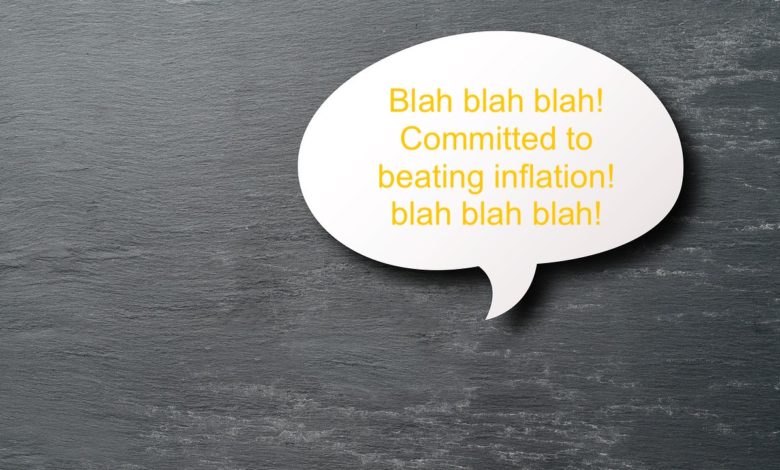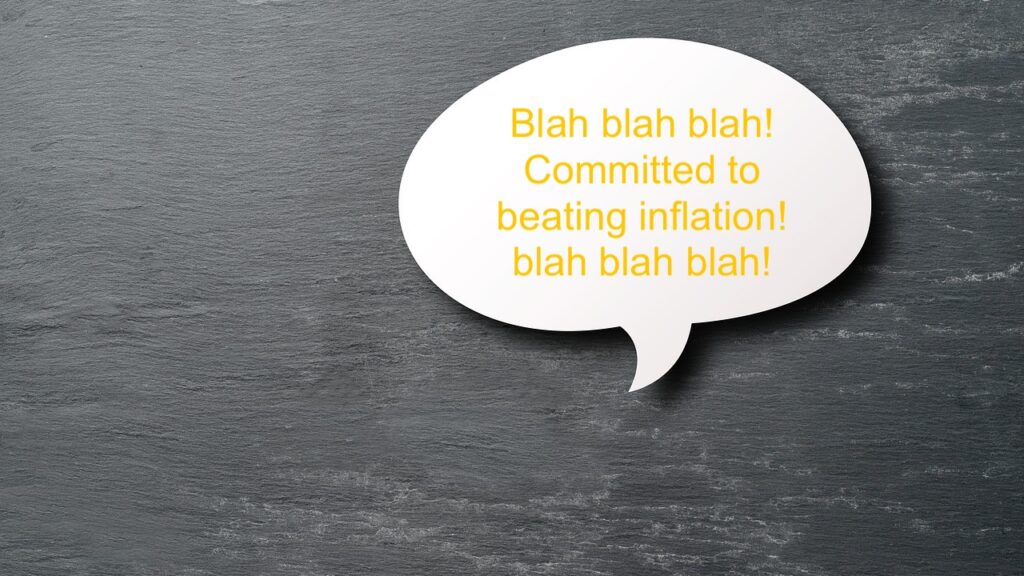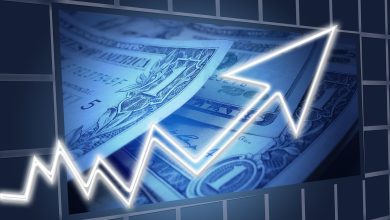Talk Is Cheap; What Will the Fed Actually Do?

Gold had dropped by over $100 in the last two weeks. Meanwhile, the dollar rose to a 7-week high on May 17. If you’re thinking that this looks a lot like how gold and the dollar moved at the height of the Federal Reserve’s inflation fight, you’re right. That’s because the central bankers at the Fed have stepped up the hawkish rhetoric in the last couple of weeks increasing expectation that interest rates will stay higher for longer.
But talk is cheap. The real question is how will the Fed respond when the bottom drops out of the economy.
Fed-Speak
Over the last two weeks, several Federal Reserve officials made comments emphasizing their resolve to carry through with the inflation fight and indicating that interest rates won’t go down anytime soon.
Chicago Fed President Austan Goolsbee, who typically tends to lean toward dovishness said it is “far too premature to be talking about rate cuts.”
Atlanta Fed President Raphael Bostic was more hawkish, saying that policymakers won’t be thinking about rate cuts “until well into 2024.” He also said he would be inclined to continue raising rates into a recession.
What we’ve seen is that inflation has been persistently high, consumers have been really resilient in terms of their spending, and labor markets remain extremely tight. All of those suggest that there’s still going to be upward pressure on prices. If there’s going to be a bias to action, for me it would be a bias to increase a little further as opposed to cut.”
Bostic also emphasized that getting inflation back to 2% is “job number one,” saying, “If there’s going to be some cost to that, we’ve got to be willing to do that.”
Cleveland Fed President Loretta Mester also took an aggressive tone, saying rates are not yet at a point where the central bank could hold steady.
I don’t put it in terms of a pause; I put it in terms of a hold. Have we gotten to that rate yet? At this point, given the data we’ve gotten so far, I would say no.”
Richmond Federal Reserve President Thomas Barkin told Bloomberg that he was “comfortable” seeing interest rates rise even further.
I think the message sent in the last statement was one of optionality, it wasn’t one of a pause or a peak. I want to learn more about what’s happening with all these lagged effects (from earlier rate hikes), but I also want to reduce inflation. And if more increases are what’s necessary to do that, I’m comfortable doing that.”
New York Federal Reserve President John Williams sounded a similar tone saying, “We haven’t said we are done raising rates,” adding, “If additional policy firming is appropriate, we’ll do that.”
This all dovetails with the hawkish tone that Jerome Powell tried to set during the press conference after the May FOMC meeting. He emphasized that the Fed is now in a “data-dependent” mode and insisted that “a decision on a pause was not made today.”
We on the committee have a view that inflation is going to come down—not so quickly, it will take some time. In that world, if that forecast is broadly right, it would not be appropriate to cut rates.”
He also hinted that the Fed could hike further, “We are prepared to do more if greater monetary policy restraint is warranted.”
As we have seen over the last year-plus, any indication that the Fed will keep hiking has boosted the dollar and weighed on gold. This has been the case over the last week as the open-mouth operations from the Fed have boosted expectations that the Fed will raise rates in June from 12% to 22%.
Meanwhile, a majority of economists polled by Reuters said they think the Fed will at least hold rates at the current level through the end of 2023 even if there is a recession.
Talk Is Cheap
But talk is cheap. It’s easy for Fed officials to say, “We’re committed to slaying inflation. We’ll keep raising rates even if the economy dips,” when the economy appears to be on relatively solid footing. The real question is what will the Federal Reserve actually do when the economy tanks.
History tells us they won’t stick to their guns, and they’ll go right back to easy money policies to prop up the economy. They did in after the dot-com bubble popped. They did it in 2008. They did it in 2018 when the stock market tanked and the economy got wobbly with just modest tightening. And they did it in spades during the pandemic.
The disconnect seems to be that Fed officials and economists in general think the looming recession will be relatively mild. In fact, after the May FOMC meeting, Powell still insisted the Fed could get price inflation to the 2% target and bring the economy to a “soft landing.”
Bank of America chief US economist Michael Gapen’s recent comments typify mainstream thinking.
In our view, rather than lean against a mild recession, the Fed would view it as an acceptable price for bringing inflation back down to target.”
Notice Gapen says “mild.”
The problem is there is no reason to believe that the coming recession will be mild. If the bust is proportionate to the boom, we’re in for one hell of a bust.
The Federal Reserve and the US government pumped trillions of dollars of stimulus into the economy during the pandemic. This was on top of the trillions of dollars it pumped into the economy after the 2008 financial crisis. It held interest rates artificially low for well over a decade. This created all kinds of malinvestments and bubbles in the economy. As Peter Schiff put it, the Fed has screwed up everything that is a function of interest rates.
Over the last year, the Fed has pushed rates to the highest level since before the 2008 financial crisis. While it still hasn’t gotten price inflation anywhere near the 2% target, there is no way that this isn’t going to break things in an economy that depends on a low interest rate environment. We’ve already seen cracks in the system with the ongoing financial crisis. The Fed managed to paper over that with its bailout, but it’s only a matter of time before something else breaks.
But right now, everything basically seems fine. Sure, we’re seeing some contraction in the economic data. But the labor market is still strong (based on the cooked government data) and consumers are still spending (themselves into record levels of debt). Until there is a crisis, nobody is going to believe there’s going to be a crisis.
Think about it. The mainstream has a pretty bad track record of seeing things coming, as Schiff pointed out during a recent interview.
Why couldn’t they see 2008 coming? That was obvious. Why couldn’t they see this inflation problem? I mean, they were claiming it was transitory when it was obvious that it wasn’t. It’s all about spin when it comes to the government. They’re never going to be honest. They’re either going to lie about what’s going to happen, or maybe they’re just so ignorant that they really can’t see what is clearly apparent to anybody who objectively looks at the facts. So, you’ve got to think for yourself and recognize that the government is never going to tell you about a crisis. You just need to prepare for it yourself.”
It’s also important to remember that the 2008 financial crisis happened over a year after the Fed stopped raising interest rates. In fact, it was already cutting rate when the Great Recession kicked off. There is always a lag between changes in policy and the impacts of those changes.
So, this brings us back to the operative question – what will the Fed policymakers do when the poo actually hits the fan? Do they have the fortitude to follow through on their tough talk? Or will they fold like an old card table?
History tells us they will fold. And until they prove otherwise, there is no reason to think they won’t. In the immortal words of Pretty Woman, “That’s the fork they know.”
When faced with a crisis, they will almost certainly implement “temporary emergency measures” to hold everything together. That means rate cuts and quantitative easing.
This is why Schiff says we’re not just facing a recession. Great Depression 2.0 is incoming.
But unlike the depression of the 1930s, where the people at least got the benefit of falling prices that provided some relief. During the depression, you lost your job, but at least the cost of living went down. And if you didn’t lose your job, you were actually better off because you had your paycheck and your paycheck went further because consumer prices fell during the 1930s. But this time, even the people who don’t lose their jobs are going to suffer because they’re going to lose the value of their paychecks. They’re going to lose the value of their savings. Because everything that you need to buy is going to be a lot more expensive. And that’s going to compound the burden for the unemployed. Because not only are they going to be without jobs, but their savings are going to be destroyed. And even if they get checks from the government, it’s not going to be enough to afford the basic necessities.”
Call 1-888-GOLD-160 and speak with a Precious Metals Specialist today!
Buka akaun dagangan patuh syariah anda di Weltrade.
Source link







